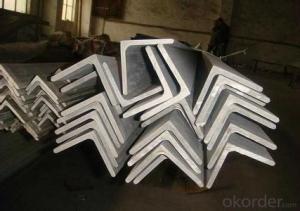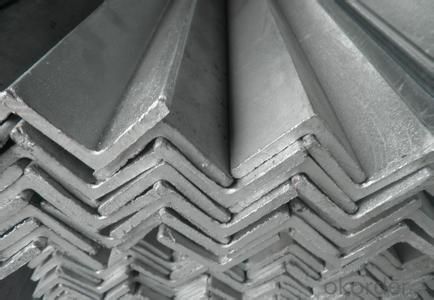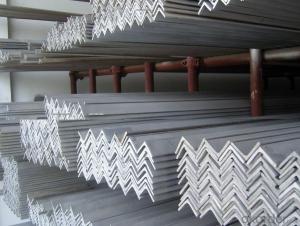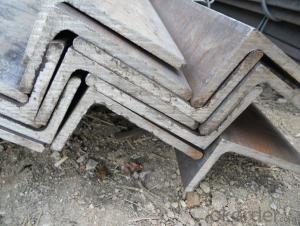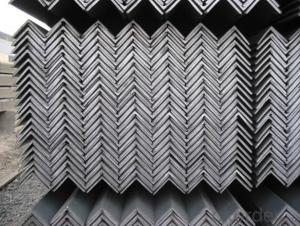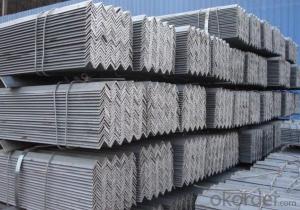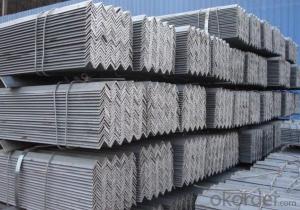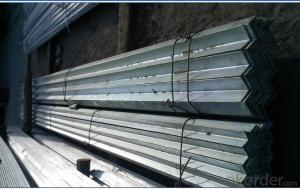ANGLE STEEL 30MM
- Loading Port:
- China Main Port
- Payment Terms:
- TT OR LC
- Min Order Qty:
- -
- Supply Capability:
- -
OKorder Service Pledge
OKorder Financial Service
You Might Also Like
Angle Steel Details:
| Minimum Order Quantity: | 25mtons | Unit: | m.t. | Loading Port: | China Main Port |
| Supply Ability: | 80000-100000MTS/YEAR | Payment Terms: | TT or LC |
Product Description:
Specifications of Angle Steel
1. Invoicing on theoretical weight or actual weight as customer request
2. Length: 6m, 9m, 12m as following table
3. Sizes

Sizes: 25mm-250mm | ||
a*t | ||
25*2.5-4.0 | 70*6.0-9.0 | 130*9.0-15 |
30*2.5-6.6 | 75*6.0-9.0 | 140*10-14 |
36*3.0-5.0 | 80*5.0-10 | 150*10-20 |
38*2.3-6.0 | 90*7.0-10 | 160*10-16 |
40*3.0-5.0 | 100*6.0-12 | 175*12-15 |
45*4.0-6.0 | 110*8.0-10 | 180*12-18 |
50*4.0-6.0 | 120*6.0-15 | 200*14-25 |
60*4.0-8.0 | 125*8.0-14 | 250*25 |
5. Payment terms:
1).100% irrevocable L/C at sight.
2).30% T/T prepaid and the balance against the copy of B/L.
3).30% T/T prepaid and the balance against L/C
6.Material details:
Alloy No | Grade | Element (%) | | ||||
C | Mn | S | P | Si | | ||
| | |||||||
|
|
|
|
|
|
| |
Q235 | B | 0.12—0.20 | 0.3—0.7 | ≤0.045 | ≤0.045 | ≤0.3 | |
|
|
|
|
|
|
| |
Alloy No | Grade | Yielding strength point( Mpa) | | ||||
Thickness (mm) | | ||||||
≤16 | >16--40 | >40--60 | >60--100 | | |||
≥ | | ||||||
|
|
|
|
|
| | |
Q235 | B | 235 | 225 | 215 | 205 | | |
Alloy No | Grade | Tensile strength (Mpa) | Elongation after fracture (%) | | |||
Thickness (mm) | | ||||||
| ≤16 | >16--40 | >40--60 | >60--100 | | ||
≥ | | ||||||
|
|
|
|
|
|
| |
Q235 | B | 375--500 | 26 | 25 | 24 | 23 | |
Usage & Applications of Angle Steel
According to the needs of different structures, Angle can compose to different force support component, and also can be the connections between components. It is widely used in various building structures and engineering structures such as roof beams, bridges, transmission towers, hoisting machinery and transport machinery, ships, industrial furnaces, reaction tower, container frame and warehouse etc.
Packaging & Delivery of Angle Steel
1. Packing: it is nude packed in bundles by steel wire rod
2. Bundle weight: not more than 3.5MT for bulk vessel; less than 3 MT for container load
3. Marks:
Color marking: There will be color marking on both end of the bundle for the cargo delivered by bulk vessel. That makes it easily to distinguish at the destination port.
Tag mark: there will be tag mark tied up on the bundles. The information usually including supplier logo and name, product name, made in China, shipping marks and other information request by the customer.
If loading by container the marking is not needed, but we will prepare it as customer request.
Production flow of Angle Steel
Material prepare (billet) —heat up—rough rolling—precision rolling—cooling—packing—storage and transportation
- Q: How do steel angles perform in high-humidity environments?
- Steel angles perform well in high-humidity environments due to their corrosion-resistant properties. The presence of moisture does not significantly affect their structural integrity, making them a reliable choice for such conditions.
- Q: How do you prevent corrosion between steel angles and other materials?
- To prevent corrosion between steel angles and other materials, there are several effective measures that can be taken: 1. Protective Coatings: Applying a protective coating such as paint, epoxy, or galvanization on the steel angles can create a barrier between the steel and the surrounding materials, preventing direct contact and reducing the risk of corrosion. 2. Insulation: Using insulating materials like rubber or plastic pads or sleeves between the steel angles and other materials can prevent direct contact and minimize the chances of corrosion. 3. Cathodic Protection: By installing sacrificial anodes or using impressed current systems, a cathodic protection mechanism can be established to protect the steel angles. This process involves creating an electrical current that counteracts the corrosion process, keeping the steel angles intact. 4. Regular Maintenance: Regular inspection and maintenance of the steel angles are crucial to identify any signs of corrosion and take appropriate actions promptly. This can include cleaning the surfaces, repairing any damaged coatings, and replacing corroded parts. 5. Proper Drainage: Ensuring proper drainage around the steel angles is essential to prevent moisture accumulation, which can accelerate corrosion. Proper design and installation of drainage systems can prevent water or other corrosive substances from pooling around the steel angles. 6. Avoiding Chemical Exposure: If the steel angles are in an environment where they may come into contact with chemicals or corrosive substances, it is important to choose materials that are resistant to corrosion. This could involve using stainless steel or other corrosion-resistant alloys that can withstand exposure to the specific chemicals present. Overall, implementing a combination of protective coatings, insulation, cathodic protection, regular maintenance, proper drainage, and material selection based on the environment can effectively prevent corrosion between steel angles and other materials, ensuring their longevity and structural integrity.
- Q: How do steel angles contribute to the overall torsional stiffness of a structure?
- Steel angles contribute to the overall torsional stiffness of a structure by providing resistance against torsional forces. The angled shape of the steel members helps to distribute and transfer these forces, preventing excessive twisting or rotation of the structure. This added stiffness helps to maintain structural integrity and stability, ensuring that the structure can withstand torsional loads and maintain its desired shape.
- Q: Can steel angles be used in transportation or infrastructure projects?
- Yes, steel angles can be used in transportation or infrastructure projects. Steel angles are commonly used in construction due to their strength and durability. They are often used to provide structural support and stability in various applications such as bridges, buildings, highways, and railways. In transportation projects, steel angles can be used for constructing vehicle ramps, guardrails, and support structures for overhead signs. In infrastructure projects, they can be used for constructing retaining walls, foundations, and supporting structures for utility installations. The versatility and reliability of steel angles make them a popular choice in these types of projects.
- Q: What are the different methods of protecting steel angles against corrosion?
- There are several methods available for protecting steel angles against corrosion. The choice of method depends on factors such as the environment, budget, and desired lifespan of the steel angles. Here are some of the commonly used methods: 1. Coatings: Applying protective coatings is one of the most effective methods to prevent corrosion. Coatings like paint, epoxy, or polyurethane create a barrier between the steel surface and the corrosive elements. These coatings should be applied in multiple layers to ensure adequate protection. Regular inspections and touch-ups may be required to maintain the coating's integrity. 2. Galvanization: Galvanizing steel angles involves coating them with a layer of zinc. This method creates a sacrificial barrier that corrodes before the steel does. Galvanization is highly effective in protecting against corrosion, especially in harsh environments. However, it may not be suitable for aesthetic applications as the zinc layer can change the appearance of the steel. 3. Stainless Steel: Using stainless steel angles is another way to protect against corrosion. Stainless steel contains a high percentage of chromium, which forms a passive layer on the surface, protecting it from corrosion. Stainless steel is particularly useful in corrosive environments such as marine or chemical industries. 4. Powder Coating: Powder coating involves applying a dry powder to the steel angles and then heating it to create a protective layer. This method offers excellent corrosion resistance and can provide a decorative finish as well. Powder coating is commonly used in architectural applications where aesthetics are important. 5. Cathodic Protection: Cathodic protection is an electrochemical method that prevents corrosion by making the steel angle a cathode in a galvanic cell. This is achieved by connecting the steel to a sacrificial anode, usually made of a more reactive metal like zinc or magnesium. The anode corrodes instead of the steel angle, providing protection. 6. Regular Maintenance: Regardless of the protective method used, regular inspection and maintenance are essential. This includes cleaning the steel angles, removing any debris or corrosive substances, and promptly repairing any damaged or scratched coatings. Regular maintenance helps to identify and address any early signs of corrosion, ensuring the prolonged lifespan of the steel angles. It is important to consult with corrosion experts or engineers to determine the most suitable method for protecting steel angles based on the specific requirements and conditions.
- Q: What are the different types of connections used with steel angles?
- There are several types of connections commonly used with steel angles, including bolted connections, welded connections, and clip connections. Bolted connections involve using bolts and nuts to fasten the angles together, while welded connections involve fusing the angles together using heat. Clip connections, on the other hand, involve using clips or brackets to connect the steel angles. Each type of connection has its own advantages and is used depending on the specific requirements and design considerations of the steel structure.
- Q: What is the maximum spacing for steel angles in a support structure?
- The spacing of steel angles in a support structure is dependent on various factors, such as the load being supported, the size and thickness of the angles, and the design criteria specific to the project. Generally, the spacing between steel angles should be determined by the structural engineer or designer based on the maximum allowable deflection and stress criteria for the given application. Steel angles are commonly utilized in support structures due to their strength and versatility. They offer stability and support to different types of loads. However, excessive spacing between steel angles can result in increased deflection and stress on the structure, potentially compromising its integrity. To establish the maximum spacing, the engineer will take into account the load-bearing capacity of the steel angles, the expected load distribution, and any relevant building codes or industry standards. The specific design criteria will dictate the allowable deflection and stress limits, which will then be utilized to calculate the appropriate spacing between the angles. It is important to note that different support structures may have varying requirements for maximum spacing. For example, in a roof truss system, the maximum spacing between steel angles may be smaller compared to a mezzanine support structure. Furthermore, the maximum spacing may differ depending on whether the angles are used as primary or secondary support members. Ultimately, the determination of the maximum spacing for steel angles in a support structure should be done through a comprehensive engineering analysis, taking into consideration the specific project requirements and safety factors. It is always advisable to consult with a structural engineer or design professional to ensure that the support structure meets all necessary safety and performance criteria.
- Q: What are the different types of connections used for steel angles in educational institutions?
- Steel angles in educational institutions can be connected using various methods. These connections play a crucial role in joining steel angles together for different applications and structural configurations. Here are some commonly used types of connections: 1. Welded Connections: Educational institutions often rely on welding to connect steel angles. This method involves melting and fusing the steel angles together using heat, resulting in a strong and durable connection. Welded connections are ideal for structural applications that require high strength and rigidity. 2. Bolted Connections: Another popular method is using bolts, nuts, and washers to secure steel angles. This type of connection allows for easy disassembly and reassembly, making it suitable for applications that require flexibility and adjustability. Non-structural applications like furniture, handrails, and brackets commonly employ bolted connections. 3. Riveted Connections: Riveting, an older connection method, involves joining steel angles using rivets. Rivets are inserted through pre-drilled holes in the angles and then hammered or compressed to secure the connection. Although less commonly used today, some older structures within educational institutions still employ riveted connections. 4. Clip Connections: Specially designed clips or brackets can be used to connect steel angles in clip connections. These clips are typically bolted or welded to the angles, providing a quick and efficient connection method. Clip connections find applications in areas where easy installation and maintenance are important, such as suspended ceilings or modular structures. 5. Gusset Plate Connections: Gusset plate connections utilize additional steel plates (gusset plates) to connect steel angles. These gusset plates are usually welded or bolted to the angles, enhancing the strength and stability of the connection. Heavy-duty structural applications like trusses or frames in educational institutions commonly employ gusset plate connections. The selection of the appropriate connection type for steel angles in educational institutions depends on factors such as load requirements, structural design, ease of installation, and maintenance considerations. It is crucial to consult with structural engineers and adhere to relevant building codes and regulations to ensure the usage of safe and suitable connections.
- Q: What are the advantages of using steel angles?
- There are several advantages of using steel angles. Firstly, steel angles provide excellent structural support due to their high strength and durability. They can withstand heavy loads and extreme weather conditions, making them ideal for construction projects. Additionally, steel angles are versatile and can be easily fabricated, cut, and welded to meet specific design requirements. They are also cost-effective, as they have a long lifespan and require minimal maintenance. Lastly, steel angles offer great aesthetic appeal, making them a popular choice for architectural applications.
- Q: What are the different methods for protecting steel angles from corrosion?
- There are multiple ways to safeguard steel angles from corrosion. Firstly, galvanization is a commonly employed technique. It involves applying a layer of zinc to the steel angle's surface. This zinc layer acts as a sacrificial anode, corroding before the steel and safeguarding it from rust. Galvanization is particularly effective in outdoor applications like construction and infrastructure projects. Another method is using paint coatings. By coating the steel angle with paint, a protective layer is formed, preventing moisture and oxygen from reaching the surface and hindering corrosion. For long-term protection, it is crucial to use high-quality, corrosion-resistant paints. Powder coating is also an option. It entails applying a dry powder to the steel angle which is then cured at high temperatures. This creates a robust and durable layer on the surface, offering exceptional resistance to corrosion. Powder coating is suitable for both indoor and outdoor applications and provides an appealing finish. Furthermore, stainless steel angles can be utilized to guard against corrosion. Stainless steel contains chromium, which forms a passive oxide layer on the surface, acting as a protective barrier. This makes stainless steel highly resistant to rust, making it a preferred choice when corrosion is a concern. Lastly, cathodic protection is a technique that involves making the steel angle the cathode in a corrosion cell. This can be achieved by connecting the steel angle to a sacrificial anode, such as zinc or aluminum, or by employing impressed current systems. By doing so, the anode corrodes instead of the steel, effectively protecting it from corrosion. It is important to consider various factors, including the intended application, environmental conditions, and budget constraints when selecting the appropriate method for protecting steel angles from corrosion. Consulting corrosion experts and considering project-specific requirements is advisable to ensure the most suitable method is chosen.
Send your message to us
ANGLE STEEL 30MM
- Loading Port:
- China Main Port
- Payment Terms:
- TT OR LC
- Min Order Qty:
- -
- Supply Capability:
- -
OKorder Service Pledge
OKorder Financial Service
Similar products
Hot products
Hot Searches
Related keywords
